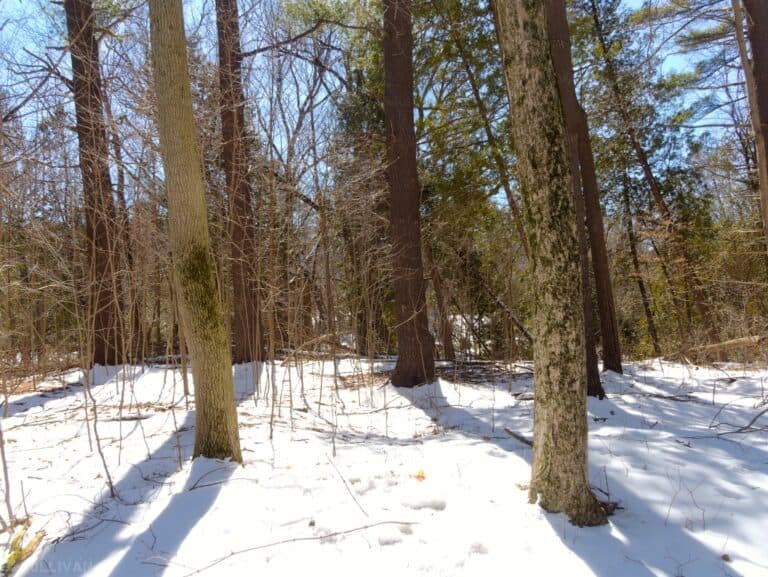There are all kinds of cherished survival myths out there. I grew up hearing them, and the guys that taught them to me probably grew up hearing them. Suck the poison out of a snake bite.

two trees about 4-6 feet apart
You can eat anything that animals eat. Drinking from white water is safer. The sad thing is none of these are true, or good ideas!
If there’s one good thing you can say about the internet, it is that it has made it remarkably easy-to-crush myths. Let’s look at another one, and put it to the true or false test. Does moss only grow on the north side of trees?
No, moss does not only grow on the north side of trees. It can grow on any side of any tree where conditions are ideal.
Myth busted, and with no survivors! Out of all those old-school survival myths I heard growing up, this is the one I most wanted to be true! How convenient would it be if we could just check any given tree for the growth of moss and then know where North is if we’re lost.
Sadly, it just isn’t the case… I’ll tell you more about why down below, along with some other related facts that you can add to your survival skill set.
Where Did the Idea Come From?
I’ve got to admit, this is one of those myths where there really is a grain of truth at the core of it, or I should say a grain of logic.
Moss is a surprisingly delicate plant, one that will only reliably grow when conditions are just right. And those conditions are, generally, that it needs a moist environment, one that isn’t too warm, and one that is shady.
Now, let’s think about solar mechanics for a minute. If the sun basically goes around the Earth at our equator, that means that the sunshine will be shining on the southerly sides of trees most of the time…
Accordingly, that intense heat can scorch moss and also dry up the moisture that it desperately needs to survive.
Here’s another clue: Moss is a nonvascular plant, which means that it cannot draw moisture in its environment. Instead, it only makes use of moisture that moves over it or is already present where it is growing.
So when you think of it that way, if the sun makes the southern sides of trees less favorable for moss, moss will grow on the north side, right?
Not exactly.

Any Forest Canopy Can Create Ideal Conditions for Moss
If you were to conduct that above scenario as a laboratory experiment under controlled and contrived conditions, it would almost certainly pan out that your moss would grow on the Northern surfaces of your trees. But that’s not indicative of the real world, particularly real forests where moss tends to grow.
That’s because of forest canopies, you know, the kind created by trees, can provide plenty of sunlight-blocking shade that will enable moss to grow pretty much anywhere beneath the canopy.
Sure, there are other variables that will affect the likelihood of moss growing and thriving, like the likelihood of moisture to collect in certain places and thin spots allowing more sunlight to come through and reach the forest floor. But that does not override this entirely sensible rule of thumb.
Moss can grow anywhere on a tree as long as those growth conditions are met. Don’t believe me? Just take a look the next time you’re out in the woods.
Do Some Kinds of Moss Only Grow on the North Sides of Trees?
Nope. Another myth, but this one fabricated from whole cloth. I’ve heard it all: it is influenced by mycelium communications, the magnetic poles of the Earth, all kinds of crazy stuff. None of it is true. All kinds of moss will grow on any given side of a tree.
Moss is Only Slightly More Likely to Grow on the North Side of Trees
As I mentioned above, there is a grain of logic to this myth.
Across all locations in the Northern Hemisphere, and across the widest possible variety of conditions and all of the different varieties of moss, it’s somewhat more likely for moss to grow on the north side because the north sides of trees are slightly more likely to support those ideal conditions.
That’s true. The problem is we are talking about a tiny, and I mean tiny, statistical difference. So small that you can’t rely on this marginal difference to inform your determination of what North is. Certainly not for navigation, and not even the northern quadrant of a tree trunk.
In the Southern Hemisphere, Moss is More Likely to Grow on the South Side of Trees!
Worse yet, if we were to head it south of the equator, what do you think would happen to this myth? That’s right, it would be reversed!
Because the sun is shining more often on the northerly sides of trees, the southern side of them becomes the side that is more likely to be ideal for the growth of moss.
But, just like the example I gave in the previous section, this is such a statistically small difference that it’s useless from a survival skill set perspective.
Don’t even try to use it for navigational purposes.
Just Get a Compass!
At the end of the day, moss isn’t something you should rely on in any context, ever, to help you figure out which way is which.
You know what will help you do that? A compass, and that’s why you should get one. A tiny button compass attached to your watch band or in a pocket survival kit will go a long way to keeping you from getting lost in the woods.
The post Moss Growing on the North Side of Trees? Busting the Myth appeared first on Survival Sullivan.
https://www.survivalsullivan.com/moss-on-north-side-of-trees/
 CampingSurvivalistHuntingFishingExploringHikingPrivacy PolicyTerms And Conditions
CampingSurvivalistHuntingFishingExploringHikingPrivacy PolicyTerms And Conditions
